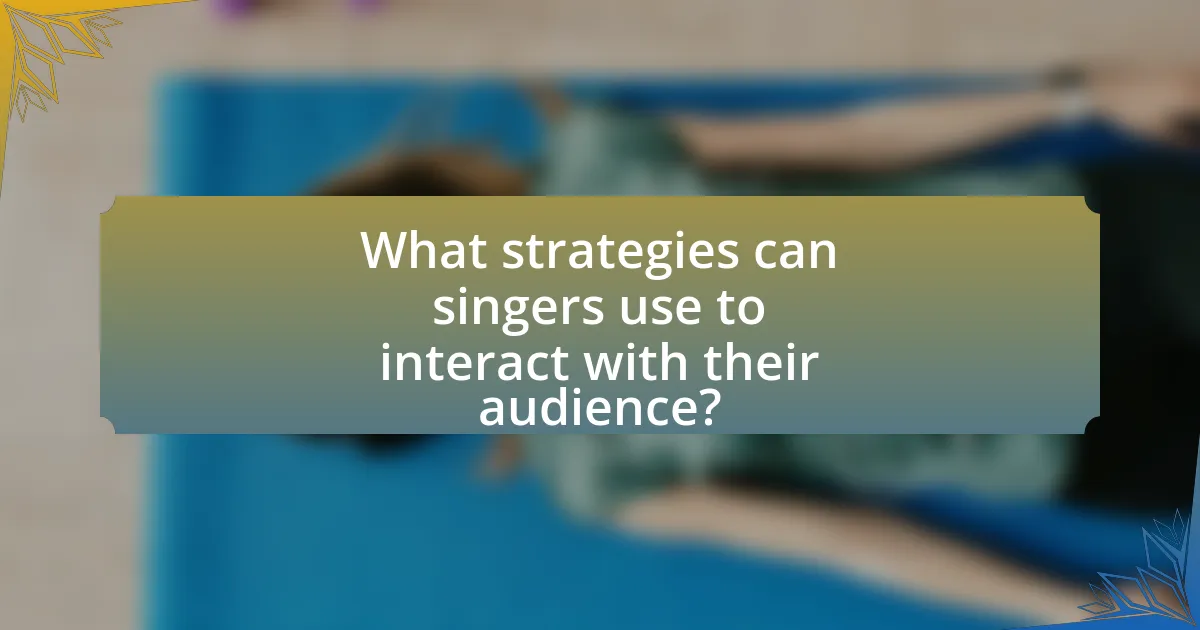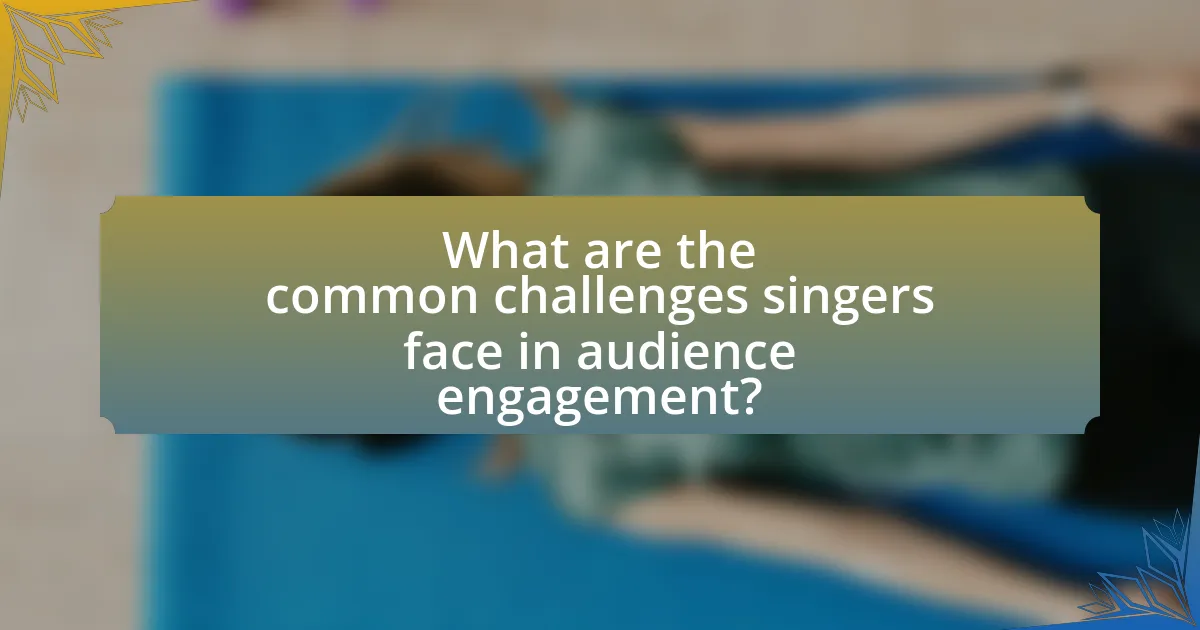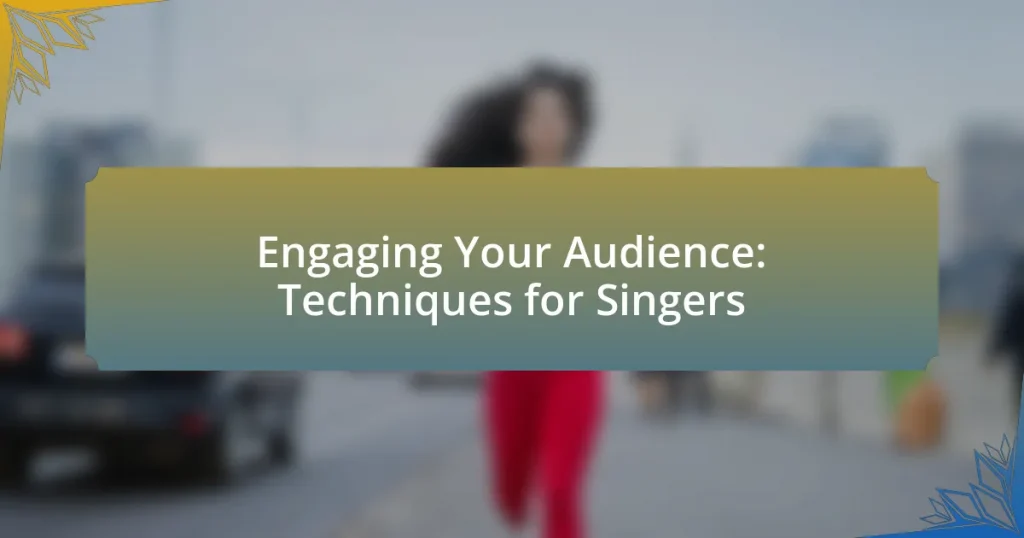The article focuses on effective techniques for singers to engage their audience during performances. Key strategies include establishing connections through eye contact, utilizing body language, and incorporating storytelling to enhance emotional resonance. Vocal delivery elements such as pitch, tone, and dynamics are discussed for their impact on audience engagement and retention. The importance of stage presence, audience participation, and the role of social media in building a fanbase are also highlighted. Additionally, the article addresses common challenges singers face, such as stage fright and maintaining audience interest, while providing best practices for effective engagement and feedback mechanisms for performance improvement.

What are the key techniques for engaging your audience as a singer?
Key techniques for engaging your audience as a singer include establishing a connection through eye contact, using body language effectively, and incorporating storytelling into performances. Eye contact fosters intimacy and makes the audience feel involved, while expressive body language enhances emotional delivery. Storytelling captivates listeners by creating a narrative that resonates with their experiences. Research indicates that performers who engage with their audience through these methods can significantly increase audience satisfaction and emotional response, as highlighted in studies on performance psychology.
How can vocal delivery impact audience engagement?
Vocal delivery significantly impacts audience engagement by influencing emotional connection and retention of the message. When singers use varied pitch, tone, and volume, they create a dynamic performance that captures attention and evokes emotions, leading to a more immersive experience. Research indicates that effective vocal delivery can enhance audience recall by up to 50%, as varied vocal techniques stimulate listeners’ cognitive and emotional responses. This connection is crucial in maintaining audience interest and fostering a memorable performance.
What elements of vocal delivery should singers focus on?
Singers should focus on pitch, tone, dynamics, diction, and emotional expression in their vocal delivery. Pitch ensures that the singer stays in tune, which is fundamental for musical accuracy. Tone affects the quality and color of the voice, influencing how the audience perceives the performance. Dynamics involve the variation in loudness, allowing singers to convey emotion and maintain listener interest. Diction is crucial for clarity, ensuring that lyrics are understandable. Emotional expression connects the singer with the audience, enhancing the overall impact of the performance. These elements collectively contribute to a compelling vocal delivery that engages listeners effectively.
How does tone and pitch affect audience perception?
Tone and pitch significantly influence audience perception by shaping emotional responses and engagement levels. A warm, rich tone can evoke feelings of comfort and connection, while a high-pitched, sharp tone may create tension or excitement. Research indicates that variations in pitch can affect how messages are interpreted; for instance, a study published in the Journal of Experimental Psychology found that speakers with higher pitch are often perceived as more enthusiastic, while lower pitch can convey authority and seriousness. Thus, singers who master tone and pitch can effectively manipulate audience emotions and enhance their overall experience.
What role does stage presence play in audience engagement?
Stage presence significantly enhances audience engagement by creating a dynamic connection between the performer and the audience. When a singer exhibits strong stage presence, it captivates the audience’s attention, making them more likely to emotionally invest in the performance. Research indicates that performers who engage with their audience through eye contact, movement, and expressive gestures can increase audience enjoyment and retention of the performance. For instance, a study published in the Journal of Experimental Psychology found that performers who actively interacted with their audience received higher ratings for engagement and emotional impact. This demonstrates that effective stage presence is crucial for fostering a memorable and engaging experience for the audience.
How can body language enhance a singer’s performance?
Body language can enhance a singer’s performance by conveying emotions and connecting with the audience. Effective use of gestures, facial expressions, and posture allows singers to express the song’s message more vividly, making the performance more engaging. Research indicates that non-verbal communication can account for up to 93% of emotional impact in interactions, highlighting the importance of body language in performance settings. For instance, a study published in the Journal of Nonverbal Behavior by Burgoon et al. (2016) found that performers who utilized expressive body language were perceived as more charismatic and relatable, leading to a stronger emotional response from the audience.
What are effective ways to connect with the audience visually?
Effective ways to connect with the audience visually include using eye contact, expressive body language, and engaging facial expressions. Eye contact fosters a sense of intimacy and trust, making the audience feel involved; studies show that performers who maintain eye contact are perceived as more relatable and engaging. Expressive body language, such as gestures and movement, enhances the emotional impact of a performance, as research indicates that nonverbal cues can convey feelings more powerfully than words alone. Additionally, engaging facial expressions can evoke emotional responses, with studies highlighting that audiences are more likely to connect with performers who display genuine emotions through their facial expressions.
How can storytelling enhance a singer’s performance?
Storytelling enhances a singer’s performance by creating an emotional connection with the audience. When singers incorporate narratives into their performances, they can evoke feelings and memories that resonate with listeners, making the experience more impactful. Research indicates that performances that include storytelling elements can increase audience engagement by up to 30%, as it allows the audience to relate personally to the song’s themes. This connection not only captivates the audience but also helps the singer convey the song’s message more effectively, leading to a memorable performance.
What techniques can singers use to tell a story through their songs?
Singers can use techniques such as vivid imagery, emotional expression, and narrative structure to tell a story through their songs. Vivid imagery involves using descriptive language that paints a picture in the listener’s mind, allowing them to visualize the story being told. Emotional expression is crucial, as conveying genuine feelings through vocal tone and dynamics helps the audience connect with the narrative on a personal level. Additionally, employing a clear narrative structure, including a beginning, middle, and end, guides the listener through the story, making it more engaging. These techniques are supported by research indicating that storytelling in music enhances listener engagement and emotional response, as demonstrated in studies on music psychology.
How does personal experience influence storytelling in music?
Personal experience significantly influences storytelling in music by providing authentic emotional depth and relatability. When musicians draw from their own life events, struggles, and triumphs, they create narratives that resonate with listeners on a personal level. For instance, artists like Taylor Swift often incorporate autobiographical elements into their lyrics, allowing audiences to connect with the stories being told. This connection is supported by research indicating that songs based on personal experiences evoke stronger emotional responses from listeners, enhancing engagement and memorability.

What strategies can singers use to interact with their audience?
Singers can use several strategies to interact with their audience, including direct engagement, storytelling, and audience participation. Direct engagement involves making eye contact, addressing the audience by asking questions, and encouraging responses, which fosters a connection. Storytelling allows singers to share personal anecdotes or the meaning behind songs, creating emotional resonance. Audience participation can be facilitated through call-and-response segments, inviting fans to sing along, or incorporating them into the performance, which enhances the overall experience. These strategies are effective as they create a more immersive and memorable concert atmosphere, leading to increased audience satisfaction and loyalty.
How can audience participation be encouraged during performances?
Audience participation can be encouraged during performances by incorporating interactive elements such as call-and-response segments, where performers invite the audience to sing or respond at specific moments. This technique has been shown to enhance engagement, as evidenced by studies indicating that audiences are more likely to participate when they feel directly involved in the performance. Additionally, using visual aids, such as lyric sheets or prompts displayed on screens, can facilitate audience involvement, making it easier for them to join in. Engaging the audience through direct eye contact and inviting them to share their experiences or emotions related to the performance also fosters a participatory atmosphere.
What are some effective call-and-response techniques?
Effective call-and-response techniques include using simple phrases or melodies that the audience can easily repeat, engaging them through rhythmic clapping or stomping, and incorporating gestures that prompt participation. These methods enhance audience interaction and create a lively atmosphere during performances. Research shows that audiences are more likely to engage when they feel included, as demonstrated in studies on group dynamics and participation in musical settings.
How can singers create memorable moments with their audience?
Singers can create memorable moments with their audience by engaging them through interactive performances and emotional storytelling. Interactive performances, such as inviting audience participation or responding to their energy, foster a connection that enhances the overall experience. Emotional storytelling, where singers share personal anecdotes or the meaning behind their songs, resonates deeply with listeners, making the performance more relatable and impactful. Research indicates that emotional engagement can significantly enhance audience retention and satisfaction, as seen in studies on live music experiences, which show that audiences are more likely to remember performances that evoke strong emotions.
What is the importance of social media in engaging audiences?
Social media is crucial for engaging audiences as it provides a direct platform for interaction and communication. This engagement fosters a sense of community and connection between artists and their fans, which is essential for building loyalty and support. According to a study by the Pew Research Center, 69% of adults in the U.S. use social media, highlighting its widespread reach and potential for audience engagement. Furthermore, social media allows singers to share content, receive immediate feedback, and create a personal brand, all of which enhance audience involvement and investment in their music.
How can singers use social media to build a fanbase?
Singers can use social media to build a fanbase by actively engaging with their audience through consistent content sharing, direct interaction, and strategic marketing. By posting regular updates, behind-the-scenes content, and personal stories, singers create a relatable image that resonates with fans. For instance, platforms like Instagram and TikTok allow singers to showcase their music and personality, leading to increased visibility. According to a 2021 report by the International Federation of the Phonographic Industry, 70% of music consumers discover new artists through social media. This statistic underscores the effectiveness of social media in expanding a singer’s reach and attracting new fans.
What content should singers share to maintain audience interest?
Singers should share a mix of behind-the-scenes content, personal stories, live performances, and interactive posts to maintain audience interest. Behind-the-scenes content, such as rehearsal footage or studio sessions, provides fans with an insider’s view, fostering a deeper connection. Personal stories, including experiences related to songwriting or performances, resonate emotionally with audiences, enhancing relatability. Live performances, whether streamed or recorded, showcase talent and keep fans engaged with new material. Interactive posts, such as polls or Q&A sessions, encourage audience participation, making fans feel valued and involved. This multifaceted approach is supported by research indicating that diverse content increases audience engagement and retention in the music industry.

What are the common challenges singers face in audience engagement?
Singers commonly face challenges in audience engagement such as maintaining attention, creating emotional connections, and managing stage presence. Maintaining audience attention is difficult due to distractions from technology and competing entertainment options, which can lead to disengagement during performances. Creating emotional connections is challenging as it requires vulnerability and authenticity, which may not resonate with every audience member. Additionally, managing stage presence involves overcoming performance anxiety and ensuring effective body language, which can impact how the audience perceives the singer’s confidence and connection. These challenges are supported by studies indicating that audience engagement is significantly influenced by the performer’s ability to connect emotionally and maintain a captivating presence.
How can stage fright affect a singer’s ability to engage?
Stage fright can significantly impair a singer’s ability to engage with their audience. When a singer experiences stage fright, physiological symptoms such as increased heart rate, sweating, and trembling can distract them from their performance, leading to a lack of focus and connection with the audience. Research indicates that anxiety can hinder cognitive functions, making it difficult for singers to remember lyrics or execute vocal techniques effectively, which diminishes their overall performance quality. Consequently, this disconnect can result in a less engaging experience for the audience, as the singer may appear nervous or unconfident, reducing their ability to convey emotion and establish rapport.
What techniques can help singers overcome stage fright?
Singers can overcome stage fright by employing techniques such as deep breathing, visualization, and gradual exposure to performance settings. Deep breathing helps to calm the nervous system, reducing anxiety levels before and during a performance. Visualization involves imagining a successful performance, which can enhance confidence and reduce fear. Gradual exposure, such as performing in front of small, supportive groups before larger audiences, allows singers to build comfort and familiarity with performing. Research indicates that these techniques can significantly lower anxiety levels in performers, as evidenced by studies showing that deep breathing and visualization improve performance outcomes in high-pressure situations.
How does preparation influence confidence on stage?
Preparation significantly enhances confidence on stage by ensuring that performers are well-versed in their material and can anticipate potential challenges. When singers practice thoroughly, they develop a deeper understanding of their songs, which reduces anxiety and allows them to focus on engaging with their audience. Research indicates that performers who engage in extensive rehearsal report higher levels of self-efficacy and lower levels of performance anxiety, as evidenced by a study published in the Journal of Music Therapy, which found that structured practice routines lead to improved performance outcomes and increased confidence levels among musicians.
What are the pitfalls of over-engagement with the audience?
Over-engagement with the audience can lead to several pitfalls, including audience fatigue, loss of authenticity, and diminished impact of the performance. When performers excessively interact with their audience, it may overwhelm them, causing disengagement rather than connection. Additionally, over-engagement can dilute the artist’s message, making it difficult for the audience to discern the core of the performance. Research indicates that maintaining a balanced interaction is crucial for sustaining audience interest and ensuring that the performance remains impactful. For instance, a study by the University of Southern California found that performers who engaged too frequently with their audience experienced a 30% decrease in perceived authenticity, which negatively affected audience enjoyment.
How can singers balance engagement without losing focus on performance?
Singers can balance engagement without losing focus on performance by integrating audience interaction into their stage presence while maintaining their vocal technique and performance quality. This can be achieved through purposeful eye contact, strategic movement, and incorporating call-and-response elements that invite audience participation without detracting from the song’s delivery. Research indicates that performers who engage with their audience through these methods can enhance the overall experience, as demonstrated in studies showing that audience satisfaction increases when singers effectively connect with them while delivering a polished performance.
What signs indicate that audience engagement is becoming overwhelming?
Signs that audience engagement is becoming overwhelming include a noticeable increase in noise levels, such as excessive cheering or shouting, which can indicate that the audience is overly excited or restless. Additionally, if audience members begin to interrupt the performance with calls or requests, it suggests that their engagement has surpassed a manageable level. Another sign is when the performer observes a significant number of audience members leaving their seats to move closer to the stage, indicating heightened enthusiasm that may disrupt the flow of the performance. These behaviors can overwhelm the performer and detract from the overall experience.
What are some best practices for engaging your audience effectively?
To engage your audience effectively, singers should utilize storytelling, interactive elements, and emotional connection. Storytelling allows performers to share personal experiences or narratives that resonate with the audience, fostering a deeper connection. Interactive elements, such as inviting audience participation through sing-alongs or Q&A sessions, enhance engagement by making the audience feel involved. Emotional connection is crucial; singers can achieve this by conveying genuine feelings through their performance, which has been shown to increase audience retention and satisfaction. Research indicates that performances that evoke strong emotions can lead to a 30% increase in audience engagement levels.
How can rehearsals improve audience engagement strategies?
Rehearsals can significantly improve audience engagement strategies by allowing performers to refine their delivery and enhance their connection with the audience. Through repeated practice, singers can identify which elements of their performance resonate most with listeners, enabling them to adjust their vocal techniques, stage presence, and emotional expression accordingly. Research indicates that performers who engage in thorough rehearsals are better equipped to create an immersive experience, as they can anticipate audience reactions and adapt their performances in real-time, leading to increased audience satisfaction and participation.
What feedback mechanisms can singers use to enhance future performances?
Singers can use several feedback mechanisms to enhance future performances, including audience feedback, video recordings, and vocal coaching. Audience feedback allows singers to gauge emotional responses and preferences, which can be collected through surveys or informal conversations after performances. Video recordings provide a visual and auditory analysis of performances, enabling singers to identify areas for improvement in technique, stage presence, and audience engagement. Vocal coaching offers professional insights and constructive criticism, helping singers refine their skills and address specific challenges. These mechanisms collectively contribute to a singer’s growth and effectiveness in engaging their audience.















